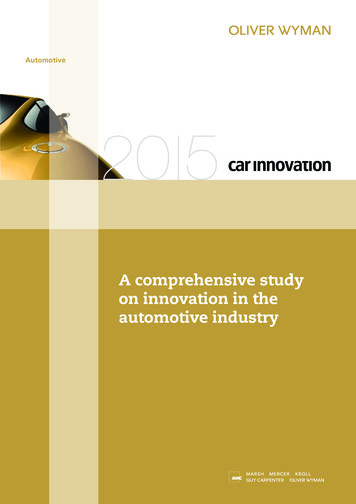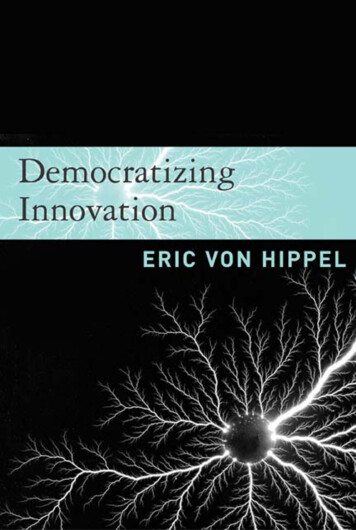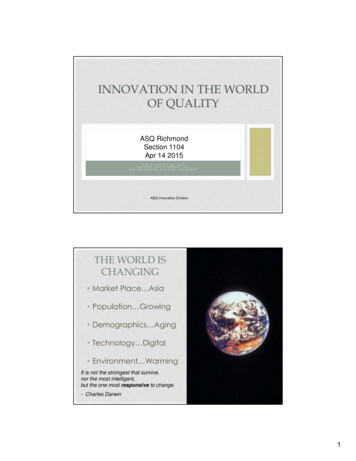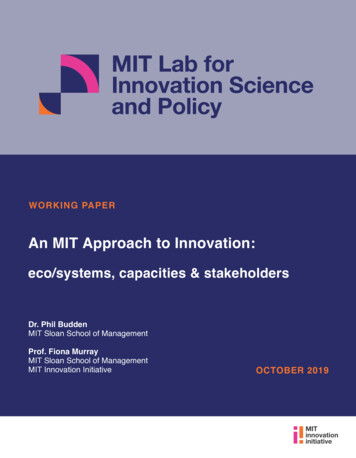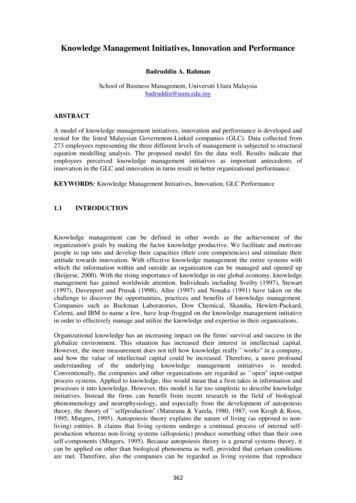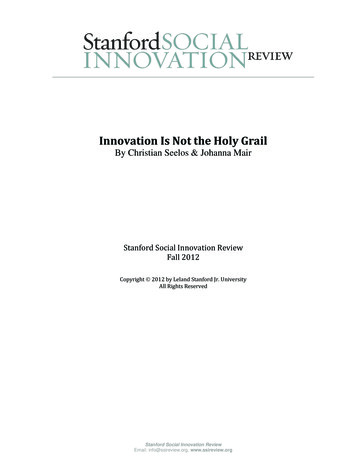
Transcription
Innovation Is Not the Holy GrailBy Christian Seelos & Johanna MairStanford Social Innovation ReviewFall 2012Copyright 2012 by Leland Stanford Jr. UniversityAll Rights ReservedStanford Social Innovation ReviewEmail: info@ssireview.org, www.ssireview.org
Innovation IsNot the Holy GrailIt is time to move from innovation as anideology to innovation as a process.By Christian Seelos & Johanna MairIllustration by Daniel HaskettEwhen desired outcomes such as positive social change can be observed.Meanwhile, organizations that are the main locus of innovation activitiesare mostly treated as a black box and we know little about how social innovation develops within these organizations.Moreover, although much social innovation research has explored theentrepreneurial establishment of new social organizations, much less isknown about the ability of already established organizations to innovatecontinuously. This is an important white space—because significant fundshave become available for innovation, but the ability of smaller, youngerorganizations to absorb large funds is limvery year, hundreds of new innovation books are publishedited. Generating impact also depends onwith well-meaning and intriguing recommendations forthe ability of organizations to operate andmanagers and organizations. They tout such innovationinnovate at the scale of the underlying sosuccess factors as a risk-taking culture, inspired lead- cial problems. The capacity of establishedership, and openness to outside ideas. An increasinglyorganizations to keep innovating, therefore,impatient social sector sees innovation as the holy grailis central to understanding the link betweeninnovation and social progress.of progress. This impatience stems in part from the perIn a recent project with the Rockefellerception that decades of traditional global development efforts are lost years, with billionsFoundation,1 we explored what enablesof dollars spent and too little to show for them. The scale of poverty-related challenges andorganizational capacity for continuousthe growing levels of global inequality drive a sense of urgency and a frustration with olddevelopment recipes. These challenges—this crisis, if you will—have legitimized a collecinnovation in established social sectortive quest for new solutions—innovations!organizations that operate at an efficientWith the focus on innovation has come a tendency to adopt the language of marketsscale delivering products and services. Weand business, such as social ventures, hybrid business models, and impact investing. Butundertook a literature review of the mainwhile the innovation language has been adopted, the existing organizational and manage- stream organizational and management litrial knowledge base on innovation has remained largely unengaged. Applied studies tend toerature on this topic, and we were amazedtreat innovation primarily as an outcome and therefore imply that social innovation occursby both the magnitude of this researchFall 2012 Stanford Social Innovation Review45
stream and the insights we gained. First, we found that both longterm evidence from studies of social sector organizations and recent empirical evidence challenge the mantra that more innovationis better. Second, we found that many of the assumptions aboutinnovations in the social sector may be misleading. And third, wediscovered that pushing innovation can stifle progress just as muchas it can enable it.No Easy Answers from Innovation Researchcapacity for productive innovation over time. In other words, if weevaluate innovation primarily by its outcome in the form of external impact, we may undervalue the positive internal organizationalimpact that comes from learning from failed innovation.Third, the hoped-for success factors for innovation that researchers and consultants have identified ignore the power of negativeorganizational factors, such as bad leadership, dysfunctional teams,and overambitious production goals.These pathologies can make the implementation of innovationsnearly impossible. Consequently, a naive trust in innovation successfactors leads to underappreciating the difficulties of making organizations more innovative, and it may generate innovation failuresby pushing the wrong factors.Thousands of scholarly and practitioner papers were published oninnovation in the last two decades alone. Although our knowledgeof many organizational and contextual aspects of innovation hasgrown tremendously, meta-reviews synthesizing innovation studiesconsistently lament the fragmented nature of innovation research.“The most consistent theme found in the organizational innova- Overrating the Value of Innovationtion literature is that its research results have been inconsistent,”Everyone talks about rock these days; the problem isstated one researcher, and it is “low in explanatory power and thusthey forget about the roll. – Keith Richardsoffers little guidance to practitioners.” 2 This does not mean thatthe literature is irrelevant. Rather, it means that we need to ques- Most of the value that established social sector organizations createtion how we use this knowledge to inform practice. Easy recipes in comes from their core, routine activities perfected over time. Effithe form of “three steps to better innovation,” often at the core of ciently producing and providing standard products and services crepopular innovation books, are not justified, no matter how tempt- ates tremendous value, particularly in places with widespread poverty.ing they may be or how plausible they may sound. Innovation is a Demand for the basics of life is high, and markets where organizationscomplex process and depends on the unique constellation of many compete to serve the poor are often inefficient or nonexistent. For ororganizational and external factors in a particular context. Serious ganizations that have found a working model in a particular context,engagement with existing organizational theories and knowledge efforts toward predictable, incremental improvements—exploitingrequires that we deal with innovation in all its complexity, and case what an organization knows how to do well, rather than developingby case. Likewise, understanding or promoting innovation in orga- innovations, exploring new activities, or creating new knowledge—nizations should force us to reflect not only on the potential factors may generate superior outcomes over time.that might make innovation work, but also on the many negativeThe Aravind Eye Care Hospital provides a vivid illustration toorganizational and contextual factors that prevent innovation or support this claim.3 Since its founding in 1976 as an 11-bed hospithe realization of its expected outcomes.tal in Madurai, India, Aravind has pursued its mission to eradicateFrom our in-depth review of the literature, we became con- needless blindness, centering on one chief intervention: cataractcerned that widely held assumptions about social innovation are surgery. Aravind resisted temptations to scale up to a full-servicenot grounded in established theoretical perspectives and may be ophthalmologic hospital, although other ophthalmologic problemsmisleading. We believe three oversights contribute to a tendency to are widespread in India. Instead, it focused on improving its speconcurrently overrate and undervalue innovation and to downplay cialization and keeping it cost-efficient. Today Aravind runs sixthe difficulties of enabling innovation in social sector organizations. Indian hospitals that perform more than 300,000 eye surgeriesFirst, innovation is often perceived as a development shortcut; annually, fighting preventable blindness at the same scale at whichthus innovation becomes overrated. The tremendous value that is it occurs in India.created by incremental improvements of the core, routine activitiesAravind’s road to becoming the world largest eye hospital wasof social sector organizations gets sidelined. Therefore pushing in- marked by a disciplined approach to developing a system based onnovation at the expense of strengthening more routine activities routines, improving practices continuously, and investing profitsmay actually destroy rather than create value.to build additional capacity. The dedication to standardization,Second, innovation in social sector organizations often has little the provision of real-time performance measures, and the focusexternal impact to show when it is enacted in unpredictable envi- on incremental improvements has driven operational productivity.ronments. Even proven innovations often fail when transferred to Aravind uses “eye camps” for fast and efficient scanning of potena different context. Yet the cumulative learning from failures may tial rural patients, transporting groups of patients needing surgibe tremendously valuable in understanding how a particular con- cal procedures to the main hospital and then back to their villages.text ticks. This potentially builds and strengthens an organization’sStrict task specialization at every level of the organizational hierarchy—reminiscent of Adam Smith’s pin factory—enables steepChristi a n Seelos is a visiting scholar at the Stanford Center on Philanthropylearning curves and focused skill development. A doctor at Aravindand Civil Society.performs more than 2,000 surgeries per year compared to an averJoh a nna M air is a professor of management, organization, and leadership at theage of about 200 in Indian hospitals. This productivity is based onHertie School of Governance in Berlin and the Hewlett Foundation visiting scholarat the Stanford Center on Philanthropy and Civil Society.deep competencies, which result in cost savings that enable treating46Stanford Social Innovation Review Fall 2012
two-thirds of the poorest patients free. Yet Aravind still earns sufficient income to enable expansion. Aravind’s high productivity isalso based on careful evaluation of practices, enabling incrementalimprovements over long periods of time. Further, the strength ofAravind’s organizational culture has grown with its productivitysuccesses.What motivates eye doctors, a scarce resource in India, as wellas nurses and other employees to work in this environment are theunique learning opportunities, the unmatched levels of surgical productivity, and Aravind’s proven and reliable ability to help the poor.Routines and competencies constantly push the frontier of Aravind’sbest practices. Meticulous screening of what does and does not workallows for small adaptations of routines and practices, which rapidlyspread across the six hospitals. The hospitals are perfect replicas ofthe original Aravind hospital, which enables sharing best practicesby eliminating variation in organizational context.Yet Aravind has had losses as well as wins. To quickly grow thenumber of cataract surgeries and to meet the ambitious goal ofreaching 1 million eye surgeries per year by 2015, Aravind in 2005started to experiment with new organizational models that forgedpartnerships with existing or new hospitals that agreed to use Aravind’s best practices. Despite an intense training and monitoringperiod involving experienced Aravind doctors, this “Managed Care”program was stopped after five years. The routines developed atand continuously improved upon and nurtured by Aravind couldnot be transferred fully to partner hospitals because of differingorganizational contexts.Aravind’s example underscores that relentless attention to incremental improvements lies at the core of an organization’s ability tobuild capacity and to make an impact on a scale appropriate to thesocial problem being addressed. Unpredictable innovation activitiesalways compete with predictable core routines for scarce organizational resources, such as staff time and money. There needs to bea healthy balance between the allocation of resources among coreactivities, which enable predictable improvements and innovations,and the allocation of resources that lead to unpredictable results.The example of Aravind also underscores that many povertyrelated and persistent problems may not need innovative solutionsbut rather require committed long-term engagement that enablessteady and less risky progress. In environments of widespreadpoverty where innovation is not triggered by changes in customerwants, new technological advances, or harsh competition, progressand impact may come more from dedication and routine work. Unfortunately, dedication and routine work do not have the sexinessfactor of innovation.Oddly, it is often the scarcity of organizational resources in established social sector organizations that legitimizes the argumentfor more innovation. But this argument is based on a wrong and dangerous assumption that innovation creates more bang for the buckand constitutes a development shortcut, solving big problems faster.In addition, social progress often depends on changing ways of organizing and the norms, habits, and beliefs of people. For example,social progress is difficult unless the roles and rights of women inrural communities change and values such as accountability, responsibility, and long-term commitment are institutionalized. Thisrequires patience, direct engagement with the poor, and dedicationthat challenges organizations to remain motivated and focused.We claim that the prevailing innovation discourse may push organizations toward adopting innovative practices, when actually more incremental developmental practices would produce more value over time.Undervaluing Failed InnovationThe best way to understand a complex system is byinterfering with it. –William StarbuckThe outcomes of innovative actions in a complex social world areinherently unpredictable. Even in business organizations that operate in established and predictable institutional environments wheresuccess is evaluated primarily by achieving quantifiable economicobjectives, innovation often fails. Social sector organizations thattackle the challenges of poverty typically operate in uncertain andoften hostile institutional environments. And they usually balancemultiple economic and social objectives. As a result, the positive andnegative outcomes of innovation are even harder to predict and evaluate. Productive social innovation thus relies heavily on trial and errorand organizational learning. And despite high error rates and littlepositive impact long term, innovation as experimentation is often anessential prerequisite to continuous social innovation.The history of Gram Vikas, an Indian nonprofit and world leaderin water and sanitation, is a great example of innovation from failure.In 1971, a group of Indian students organized the Young Students’Movement for Development (YSMD) and moved to the state of Orissato serve victims of a devastating cyclone and to promote equalityand inclusive development. The student-activists’ first attempt atinnovation was to use lift irrigation systems to help local farmerspump water from the rivers of the Orissa delta region, so that theycould grow more than one crop per year. The richer landowners ofthe region at first agreed to donate land to jump-start the studentproject. But once they saw the increased yields and potential profits that resulted from the irrigation system, they took back the land.Gram Vikas (which was known as YSMD until 1979) failed to achieveits goal of creating collective village landholdings and thus ensuringa basic livelihood for poor farmers in Orissa. Yet this failed instanceof innovation was critical for the young organization’s understanding of local power structures and poverty.Indeed, the irrigation failure informed its next experiment: theintroduction of cow tending and dairy production to extremely poorand marginalized communities. In 1976, Gram Vikas joined a nationwide effort to develop a network of small-scale dairies that wouldform cooperatives and help producers retain more profits from theirefforts. The dairy grid was seen as a chief development instrumentin rural areas over the next decades. But after only one year, GramVikas realized that dairying was not going to work. “It did not takelong to realize that dairying was neither feasible nor what was neededurgently for the people of the area,” said Joe Madiath, founder ofGram Vikas, in a 2005 interview. “There was no infrastructure orany kind of veterinary support. We [also] felt that we were moreconcerned about the animals, the repayment of the loan, the sale ofmilk, etc., than about the people and their acceptance of a new wayof keeping cows. We perhaps overmanaged the scheme for the people,Fall 2012 Stanford Social Innovation Review47
Sixwith the result that they neverHundreds of factors within andRecommendations for Productiveexternal to organizations havereally got sufficiently involved,Innovation in Social Sector Organizationsand soon most of them optedbeen identified that directly ororganizations to determine1. Treat innovation primarily asto sell the cows.”indirectly affect the characa process, not as an outcome.how they might enable orAlthough Gram Vikas deteristics and dynamics of instifle innovation.2.Treatinnovationasanindecided to abandon the intervennovation. Productive innovapendent variable, and reflect5. Capture insights from suction, the process of experimenttion therefore depends on theon multiple positive and negcessful and unsuccessfuling in remote villages and beingconstellationof a large numberative outcomes during theinnovations in organizationsexposed to the customs andofenablingorganizationalandinnovation process.over time.realities of adivasis (tribal vilcontextualfactors.Butevena3. Recognize that innovation pro6. Reflect on the differences inlagers) surfaced a chief reasonsinglenegativefactor,suchasacesses integrate different orgainnovation processes, influnizational and external factors.for the villagers’ poor healthshortsightedleaderoracultureencing factors, and outcomesand poverty: lack of sanitation.that is hostile to change, mayacross different cultures and4. Understand the prevailinggeographies rather than oncognitive, normative, andWith financial support fromprevent innovation.political dimensions withingeneral innovation factors.international development orThe consequences of negaganizations such as the Swisstive factors often fall into twoDevelopment Agency, Grammain realms. First, in some orVikas’s Rural Health and Environment Programme was launched ganizations too many bad ideas are pursued, and this is coupledin the early 1990s. Systematic learning from a series of earlier de- with an inability to learn from or act on the resulting failures; then,velopment interventions, such as building biogas plants in remote when little value is created, collective cynicism lowers the chancevillages, allowed Gram Vikas to build the capabilities and outreach that future ideas will be enacted with sufficient support, motivaneeded to implement health-related initiatives at a large scale. Today tion, and commitment. Second, in some organizations, too few goodGram Vikas brings water and sanitation to more than 1,000 villages ideas get developed into innovative new activities, new operatingand 66,000 families in Orissa. Its programs help empower com- and management processes, or new products and services; ambimunities to construct, manage, and maintain their own sanitation tions and expectations are reduced and creative ways are devisedfacilities as well as to launch development initiatives that improve to justify the status quo.There is no shortage of anecdotal evidence of this problem. Wecommunity health and quality of life.The story of Gram Vikas shows that innovation as experimen- all have lamented the lack of new ideas and innovation in bureautation can be a major mechanism for progress. Although the error cracies on both the funding and project implementation sides. Andrate of this type of innovation is high, experimentation that leads we have bemoaned the failed doctrines of traditional developmentto innovation failures can slowly improve an organization’s under- organizations, driven by a belief that progress comes from followingstanding of how a particular environment ticks. Experimentation recipes developed in the Western world and involving large-scalecan enable social sector organizations to find ways to remove or financial and technical support from consultants and project manwork around hurdles and to create slow but continuous and cru- agers who lack local commitment or have limited understandingcial progress. Although productive innovation does not always of local contexts.translate into desired outcomes or impact, systematic learningA more recent example of this problem may be several CEOs’and building of a knowledge base about what works and what fascination with Muhammad Yunus, founder of Grameen Bankdoes not constitutes an important indicator for an organization’s and winner of the 2006 Nobel Peace Prize. Yunus acknowledgesthat his idea to use the efficiency of multinational corporations tocapacity to innovate.We claim that evaluating the innovation performance of organizations eliminate poverty faster has appealed to many people in the corprimarily based on positive outcomes may stifle the risky experimenta- porate sector. Since 2007, companies such as Danone, Veolia, Intel,tion necessary for progress in difficult and unpredictable environments. Adidas, and BASF have embraced this idea and marched into Bangladesh to build innovative new “social businesses.” Unfortunately,Underappreciating the Difficultythe CEOs involved have largely failed to explain the rationales forof Innovationthese innovations and to communicate concrete expectations fortheir companies or for social progress in Bangladesh.A very high percentage of nonprofit and government innovationYunus recounted in 2007 how the Grameen-Danone partnershipoccurs against the odds, brought forth in organizations that aredeveloped. “The idea of the company,” he wrote on his website, “washostile to change. –Paul Lightborn over just a casual lunch I had with Franck Riboud, chairmanThe focus on outcomes and impact in the social innovation lit- and CEO of Groupe Danone, a large French corporation, a worlderature implies that the organizational side of social innovation is leader in dairy products. It took just that time for me to convincetrivial and can be enacted by just doing the right things. The impa- him that an investment in a social business is a worthwhile thingtience with making fast progress has fueled a hunt for the critical for Danone shareholders. Even though it will not give any personalsuccess factors that can drive more innovation in organizations. dividend to them, he agreed to the proposition even before I fullyYet from our literature review, this perspective has serious flaws. explained it to him.” 448Stanford Social Innovation Review Fall 2012
Is it that successful Western companies and their CEOs sufferfrom excessive organizational optimism—a feeling that their advanced competencies ought to be valuable in dealing with widespreadpoverty? Yet if organizations strategize this way, bad innovationdecisions are usually the consequence. We and other researchers5find it questionable whether productive innovation can be expectedwhen CEO decisions trump a thorough and realistic analysis of thecomplexities, challenges, and time scales involved in doing “business with the poor.”Organizational research has unearthed a large number of cognitive, normative, and political factors that can stifle innovationor derail innovation processes.6 We therefore are frustrated thatpushing innovation based on simple recipes and success factors isstill the prevailing dogma of organizational leaders, consultancies,and prescriptive research papers. It reminds us of the frantic huntfor the next miracle diet guaranteeing weight loss in seven days. Westrongly believe that unless leaders engage in an honest and criticaldiagnosis and evaluation of negative organizational factors and innovation hurdles, the well-meaning recommendations provided bythe innovation literature may not have much impact.We claim that pushing innovation success factors while disregardingprevailing organizational hurdles may create negative outcomes and stifleinnovation performance.Implications for Social InnovationThe focus on positive outcomes that legitimize innovation for socialsector organizations has generated a bewildering and confusing setof descriptions of what innovation is and how to achieve it. Thesedescriptions and prescriptions stifle progress, because knowledgefails to accumulate and the assumptions underlying terms such associal innovation are questionable.It is time to move from innovation as an ideology to innovationas a process—a transition that might be less glamorous but willbe more productive. From studying existing research on organizational innovation and from our own research on the subject, wehave distilled six recommendations for productive innovation insocial sector organizations:1. Treat innovation as a process, not primarily as an outcome. Efforts to explicitly link the characteristics and dynamics of organizational innovation to its consequences provide valuable evidencefor decision making and enable organizations to identify areas forproductive support as well as to fine-tune interventions and resourceprovision strategies.2. Treat innovation as an independent variable, and reflect on multiple positive and negative outcomes during the innovation process. Thefocus on innovation within organizations enables an accurate assessment of the internal and external dimension of value createdby innovation activities.3. Recognize that innovation processes integrate different organizational and external factors. These factors include individuals (e.g.,idea creation), groups (e.g., idea evaluation), organizations (e.g.,resource allocation and formalization of new activities), and contexts (e.g., external power structures or collaboration partners).Evaluating innovation requires consideration of several levels ofanalysis concurrently.4. Understand the prevailing cognitive, normative, and political dimensions within organizations to determine how they might enable or stifleinnovation. This could allow younger organizations to better monitorand suppress emerging negative innovation factors and increase theirlearning and innovation capacity. And it could allow more matureorganizations to develop more focused organizational redesigns, torejuvenate processes, and to legitimize tough but necessary decisions.5. Capture insights from successful and unsuccessful innovations inorganizations over time. This approach to social innovation trumpsprevailing approaches that generalize innovation factors based onstatic snapshots across organizations or based on single observationsof innovation events. It also tests for the presence or absence of animportant enabler of innovation: organizational learning.6. Reflect on the differences in innovation processes, influencing factors, and outcomes across different cultures and geographies rather thanon general innovation factors. We know very little about such innovation-related factors as creativity, idea evaluation, and learning inorganizations as they apply to non-Western settings.These recommendations should enable social sector organizations,their stakeholders, and researchers to develop analytical models andtools to unearth negative factors that prevent productive innovation.Similarly, funders who carefully think through the implications outlined in this article may find ways to escape over-supporting fashionable innovation initiatives and under-supporting promising butdifficult innovation efforts, particularly those in complex environments where formulas for social progress have not yet been found.Finally, our process approach to social innovation is an attemptto swing the pendulum back from the supply side of social innovation to the demand side of social innovation. Glorifying innovationas “the” solution to social and environmental needs and problemshas led to well-intended efforts to increase the population of socialinnovators and entrepreneurs. This certainly has its merits, but ithas come with a detriment to investments in established social sector organizations that operate at scale and that create value mainlythrough incremental improvements. Our hope is that an increasedemphasis on innovation as a process will help avoid bad social sector investments and thwart unproductive debates about quick fixesto entrenched social problems. nThe authors wish to thank the Rockefeller Foundation for financial support of ourresearch on innovation, and the Stanford Center on Philanthropy and CivilSociety for hosting our work.Note s1 Christian Seelos and Johanna Mair, “What Determines the Capacity for ContinuousInnovation in Social Sector Organizations?” Stanford PACS Report to the RockefellerFoundation, January 2012.2 Richard A. Wolfe, “Organizational Innovation: Review, Critique, and SuggestedResearch Directions,” Journal of Management Studies 31(3), 1994.3 V. Kasturi Rangan and R.D. Thulasiraj, “Making Sight Affordable,” Innovations 2(4), 2007.4 Muhammad Yunus, “Social Business,” 2007. ess5 Christian Seelos and Johanna Mair, “Profitable Business Models and Market Creation in the Context of Deep Poverty: A Strategic View,” Academy of Management Perspectives 21(4), 2007; Bernard Garrette & Aneel G. Karnani, “Challenges in MarketingSocially Beneficial Goods to the Poor,” California Management Review 52(4), 2010.6 Jan Schilling and Annette Kluge, “Barriers to Organizational Learning: An Integration of Theory and Research,” International Journal of Management Reviews 11(3), 2009.Fall 2012 Stanford Social Innovation Review49
Not the Holy Grail E very year, hundreds of new innovation books are published with well-meaning and intriguing recommendations for managers and organizations. They tout such innovation success factors as a risk-taking culture, inspired lead-ership, and openness to outside ideas. An increasingly impatient social sector sees innovation as the .



